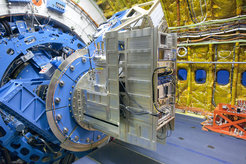High flying astronomy with German instrument
Infrared Spectrometer on board the SOFIA observatory successfully completes maiden flight
As the Jumbo touched down on the runway of the Dryden Aircraft Operations Facility in Palmdale/California at 6.40 am local time it heralded in a new era for observational astronomy: it was April 6, 2011, and the jet which had been converted into the SOFIA infrared observatory had just completed its first research flight with GREAT, the spectrometer developed by a team which included the Max Planck Institute for Radio Astronomy. The observation programme included the M 17 molecular cloud, a region of our galaxy with increased star formation, and also galaxy IC 342 only a few million light years away.
![Great! The GREAT instrument has recorded the first terahertz photons from the M 17SW star-forming region. Selected spectra of ionised carbon ([CII], white line) and warm carbon monoxide (CO, green line) are shown superimposed on a false-colour image in the near infrared region, measured by the Spitzer space telescope. GREAT’s high spectral resolution is necessary in order to be able to study the velocity structure across the cloud using the line profiles. The region measured is shown in red, and the velocity integrated distribution of [CII] and CO is shown in the inserts at the bottom. The scientists use the new data to investigate the transition region, where the molecular cloud is exposed to the ionizing radiation of massive stars.](/4045607/original-1518434652.jpg?t=eyJ3aWR0aCI6MjQ2LCJvYmpfaWQiOjQwNDU2MDd9--d0f9b37043ac1350ecc68bd93cc51679c0071a9c)
“These very first spectra recorded by GREAT are the reward for investing years of hard work in cutting-edge technology developments for the spectrometer. They demonstrate the outstanding scientific potential of airborne far-infrared spectroscopy,” says a delighted project leader Rolf Güsten, one of the scientists at the Max Planck Institute for Radio Astronomy in Bonn/Germany, after the maiden flight. The large collecting area of the 2.7-m diameter telescope coupled with great progress in terahertz technologies in recent years allow GREAT to collect data 100 times faster than in earlier experiments. “This opens up the way for unique scientific observations.”
GREAT is an acronym for German Receiver for Astronomy at Terahertz Frequencies and was developed under Güsten’s leadership by researchers at the Bonn Max Planck Institute and the University of Cologne, in collaboration with the Max Planck Institute for Solar System Research and the DLR Institute of Planetary Research. The instrument uses the high flight altitude of the SOFIA stratospheric observatory, currently the only flying observatory in the whole world, because at altitudes of ten to 13 kilometres above ground level the earth’s atmosphere becomes transmissive to the far-infrared radiation from space as well, radiation which is absorbed by the water vapour in the layers below. This gives the observatory access to spectral lines which are important for astronomical observations.

On its flight on April 6, GREAT observed not only the radiation from ionised carbon at a frequency of 1.9 terahertz (corresponding to a wavelength of 0.158 millimetres) but also spectral lines of warm carbon monoxide at high excitation in the M 17 and IC 342 sources. These lines bear witness to atomic processes which lead to a cooling of the interstellar matter. The balance between heating and cooling processes, on the other hand, regulates the temperature of the interstellar medium, thereby controlling the initial conditions for the formation of new stars.
Jürgen Stutzki from the University of Cologne, the team’s second project manager, says: “The ionized carbon line is excited by the intense ultraviolet radiation from new-born stars. It provides us with a unique insight into the physical processes and chemical conditions in the stellar nurseries. SOFIA enables us to understand how infant stars form and how they change the clouds which gave birth to them.”
“The receiver’s first scientific flight marks the beginning of German-American scientific collaboration in the SOFIA project. We are looking forward to the future measurement operations with confidence," says Alois Himmes, SOFIA Project Manager at the German Aerospace Center (DLR). After these initial characterization flights, the observatory will become available for the use of interested astronomers. “In summer 2011, German astronomers will conduct scientific observations with SOFIA for the first time,” explains Alfred Krabbe, the Head of the German SOFIA Institute (DSI) at the University of Stuttgart.
(HOR / NJ)
![Great! The GREAT instrument has recorded the first terahertz photons from the M 17SW star-forming region. Selected spectra of ionised carbon ([CII], white line) and warm carbon monoxide (CO, green line) are shown superimposed on a false-colour image in the near infrared region, measured by the Spitzer space telescope. GREAT’s high spectral resolution is necessary in order to be able to study the velocity structure across the cloud using the line profiles. The region measured is shown in red, and the velocity integrated distribution of [CII] and CO is shown in the inserts at the bottom. The scientists use the new data to investigate the transition region, where the molecular cloud is exposed to the ionizing radiation of massive stars. Great! The GREAT instrument has recorded the first terahertz photons from the M 17SW star-forming region. Selected spectra of ionised carbon ([CII], white line) and warm carbon monoxide (CO, green line) are shown superimposed on a false-colour image in the near infrared region, measured by the Spitzer space telescope. GREAT’s high spectral resolution is necessary in order to be able to study the velocity structure across the cloud using the line profiles. The region measured is shown in red, and the velocity integrated distribution of [CII] and CO is shown in the inserts at the bottom. The scientists use the new data to investigate the transition region, where the molecular cloud is exposed to the ionizing radiation of massive stars.](/4045607/original-1518434652.jpg?t=eyJ3aWR0aCI6MzQxLCJmaWxlX2V4dGVuc2lvbiI6ImpwZyIsIm9ial9pZCI6NDA0NTYwN30%3D--1bde96ddeb0be5674f5e345e5260ec13aab375a5)
